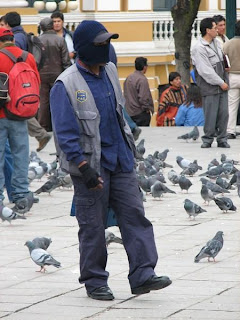No red carpets please this time....
Just a couple of bizzar things that struck me as noteworthy here in Bolivia:
-

loads of Bolivian women wear the bowler, or English derby hats, yep, the ruond hats gentlemen used to wear, in fashion in the 1930 (I think). Not really conveniently one would think, since they aren t that stable, don t protect that much from either cold or heat but hey, random things ahhpen. Apprently some salesmen in the 1940 got them here and didn t know what to do with them, so sold them as ladies hat, and a fashion was born. An Italian firm then leapt on it and started massively importing these hats into Bolivia...

Note that non-verbal communication takes many forms. The women of Bolivia, so anthropologists surmise, wear what we know as hat because it emulates the headgear of the conquistadores. The height, angle, and decoration of the hat denotes subtle meaning, e.g. status, rank, family group, etc. A single hat can cost as much as a months wages...
 - Shoepolishers: after my desastrous busride in which we got stuck and all had to push the bus through the river, well, the state of my shoes left to desire... Surprised they even let me enter the hostel. So, next day I am walking looking around for a shoe polisher (never underage, since I don t want to keep them out of school). Sitting quietly at the marketsquare, suddenly a man with a hood over his head and a ski mask over his face (no kidding) approaches me and waves some sort of weapon at me. Already willing to hand over my wallet and personal belongings (yet again), I stop to think a sec and check out his weapon, which turns out to be... a shoe brush! Shoepolishers found. He said he wears the mask for protection against the fumes and smell of the products he uses, but after chatting with some more Bolivians, it could have more to do with social stigmatisme and they don t want to be recognised, as students paying their way through school or helping the family....
- Shoepolishers: after my desastrous busride in which we got stuck and all had to push the bus through the river, well, the state of my shoes left to desire... Surprised they even let me enter the hostel. So, next day I am walking looking around for a shoe polisher (never underage, since I don t want to keep them out of school). Sitting quietly at the marketsquare, suddenly a man with a hood over his head and a ski mask over his face (no kidding) approaches me and waves some sort of weapon at me. Already willing to hand over my wallet and personal belongings (yet again), I stop to think a sec and check out his weapon, which turns out to be... a shoe brush! Shoepolishers found. He said he wears the mask for protection against the fumes and smell of the products he uses, but after chatting with some more Bolivians, it could have more to do with social stigmatisme and they don t want to be recognised, as students paying their way through school or helping the family....
- Welcome to the "Witches Market", one of the most fascinating (although a bit macabre for some) and not-to-be-missed sights in La Paz.
This uncovered market is a collection of stalls along a couple of streets; the vendors are mostly indigenous women known as "cholas" or "cholitas", dressed in traditional regalia, the majority of whom speak Spanish (although only just) and at least one (if not both) of the traditional languages, Aymara and Quechua. A cholo (masc.), chola (fem.) is a person of mixed parentage - although they have indigenous features and could well pass for pure Indians, they are in fact descendants from a mixture of mestizo (half-cast person, mixture of Spanish and Indian) and Indian parents. This term is used in all Andean countries, but whilst in Bolivia it has a friendly connotation and the women enjoy certain social status, in Peru and Chile for example the term is used negatively (mestizos were looked down upon by both the white and the pure indigenous population).
In these stalls you will find a fantastic array of weird and wonderful items, the most eye-catching of all possibly being the desiccated frogs, snakes and other animals, and the llama foetuses. Yep, you read that right… foetuses.
Many will believe that this is just a tourist trap, but they'd be wrong. Many Bolivians shop here regularly, not just the poor, uneducated people, who are the ones more commonly associated with this kind of “superstition” as we would call it, but also well educated, professional people, who come here in search of a bit of luck, a recipe to boost their own businesses, or even (why not?) the perfect love potion. Some say even politicians will pop round from time to time (perhaps when the next election is due?).
The cholas will listen to your requirements and put together a customised bundle to fit your particular needs. The bundle can include any number of items such as herbs, coca leaves, sweets, small amulets made of clay… it then needs to be burnt and the ashes spread on the ground in order to release the magic within. Not all the bundles serve a selfish purpose - many are burned as offerings to Pachamama, or Mother Earth, towards whom Andean people feel great reverence for.

No comments:
Post a Comment